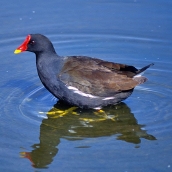Moorhen (Gallinula chloropus)
This aquatic bird measures from 27-31 cm in total length, wingspan from 50-55 cm. The back is dark brown, unlike the rest of the plumage, which is slate-grey. The bill is red and yellow-tipped and the legs are yellow. It has white flashes on the flanks and the underside of the tail. It breeds in the Azores (Flores, Terceira, São Miguel and Santa Maria), Madeira (including Porto Santo), the Canaries (La Palma, La Gomera, Tenerife, Gran Canaria and Fuerteventura) and Cape Verde (Boavista and Santiago). It has also been reported as a vagrant species in the Savage Islands and there have been sightings on various islands where it does not breed, e.g., El Hierro, Lanzarote (Canaries) and São Vicente (Cape Verde). It inhabits artificial wetlands (ponds, pools and dams), lakes and natural lagoons (mainly in the Azores), ravines with permanent running water (in the Canaries and Cape Verde) and artificial water channels (in the Canaries), provided there is some marginal vegetation. This bird is an omnivore, feeding on invertebrates as well as vertebrates, particularly if they are aquatic (e.g., frogs), although it leaves the water to eat the shoots and fruits of certain grasses and shrubs. It also feeds on aquatic plants growing in its habitat. It generally breeds in spring between February and August, except in the Azores where it does not begin until March. Two or three clutches of 4-13 eggs are produced each year, six to eight being more usual. Nests can be located among marginal vegetation, but they are also made to float and are sometimes built inside dead trunks, pipes and walls close to the water. The survival rate of the chicks is low and only one to three reach maturity. The range of the moorhen is expanding in Macaronesia, where it has gradually colonized most aquatic settings. Populations are abundant, but only a few breeding pairs remain in just two locations on Cape Verde; on Madeira they are relegated to a very few localities. Moorhens tend to gather in large flocks, particularly outside of the breeding season, and 20 or 30 individuals can be seen in the same stretch of wetland. Threats include the destruction and decline of pools traditionally inhabited by this species, the ensuing degradation of marginal vegetation, variations in water levels, chemical dumping, poaching, predation by introduced mammals (cats and rats) and roadkill.













